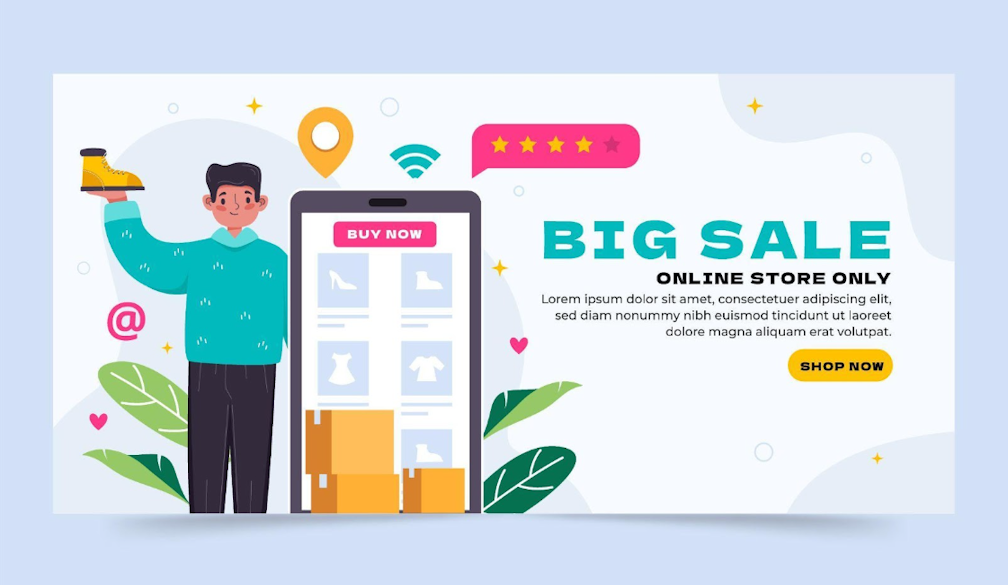6 Reasons Your eCommerce Needs an App Today

More than 78 percent of all eCommerce traffic now comes from smartphones. That number is not part of a temporary shift. It reflects a permanent change in how people shop, how they compare prices, and how they expect brands to respond. If your online store is still depending on a mobile-optimized website alone, then you are giving potential buyers a slower and less satisfying experience than what they now consider normal.
Many eCommerce businesses hesitate to build an app because they think it is too early or too expensive. But the truth is that the longer you wait, the more customers you lose to competitors who already offer a smoother mobile journey. Apps are not just about convenience. They are about control, retention, and long-term revenue.
This blog breaks down the six most urgent reasons your store should not delay mobile app development. If you are serious about scaling your business, this is not a suggestion; it is your next step.
Top 6 Reasons Your eCommerce Business Needs a Mobile App
Here are the most important reasons why your brand should stop delaying and start building an e-commerce app today:
1. Mobile Apps Improve Customer Retention and Repeat Sales
It is not just about getting people to visit your store once. It is about bringing them back, keeping them engaged, and giving them reasons to choose you over someone else every time. Mobile e-commerce apps with solid features help you do that better than any other channel.
Once installed, the app becomes a familiar space. It remembers a user’s preferences and shows them what they are most likely to want next. Product recommendations are not random, as they are based on browsing and purchase history. This kind of tailored experience builds loyalty in ways generic websites never can.
You also get to create direct communication lines through push notifications. If someone adds a product to their cart but leaves before checking out, the app can remind them an hour later. That reminder is not buried in their email. It shows up where they are already looking on their phone. Over time, small nudges like this create long-term habits. When customers feel seen and remembered, they are more likely to stay. Apps make that possible without requiring massive ad budgets or complex email funnels.
Case Highlight: Starbucks
Starbucks did not just launch an app, they built a retention machine that pays off daily. The app links digital ordering and payment to a rewards program that gives customers points for every transaction. People return not only for coffee but also to keep earning and unlocking rewards. This habit is what drives higher frequency and stronger loyalty. Most of their repeat sales now come from users who shop directly inside the app without ever waiting in line. Starbucks proved that the combination of convenience and reward inside a mobile experience leads to better long-term retention than any website can offer.
2. Conversion Rates Are Higher on Mobile Apps Than Mobile Sites
If your traffic looks healthy but sales lag behind, your problem is probably not awareness. It is conversion. Mobile apps remove the obstacles that make users hesitate or abandon their carts.
On a typical mobile site, users must wait for pages to load, re-enter shipping information, and sometimes even re-log into their accounts. That friction causes hesitation. And hesitation is one of the biggest killers of conversions.
With a well-built mobile app, these delays vanish. Payment details are saved and delivery preferences are remembered. The entire checkout process takes less than a minute in most cases. Every second saved increases the likelihood of a sale.
Speed is not the only advantage. The user interface is also cleaner and buttons are easier to click. Plus, filters are simpler to apply and everything feels intentional. That feeling reduces doubt and encourages action. Better conversions mean more revenue without having to grow your traffic. That alone makes the case for launching an app sooner rather than later.
Case Highlight: Walmart
Walmart focused hard on mobile performance and saw direct results. After redesigning its mobile experience with app-first principles, Walmart’s Canadian division reported a massive percent boost in conversion rates and almost doubled its mobile sales. The app offered better speed and more intuitive navigation than their old mobile site. That change alone pushed more shoppers to complete their purchases without stalling at the checkout page. Their data showed that when the friction dropped, the revenue went up, exactly what mobile apps are designed to do.
3. Apps Give You More Control Over Marketing and Customer Reach
When your only communication channels are ads and email, you are constantly at the mercy of someone else’s platform. Algorithms shift and inbox filters get tighter. Your reach can disappear overnight.
A mobile app puts you in control. You can send personalized offers through push notifications directly to people who have chosen to install your app. That is a permission-based channel that does not require bidding or beating spam folders.
You also get control over how your promotions look and function. You are not limited by social media templates or advertising restrictions. In your app, you decide how a product gets showcased, which bundles to feature, and when to show urgency prompts. Segmenting users is also easier. You can tag users by their purchase behavior, geographic location, or time of day they shop. This means every notification or offer can be more relevant. More relevance leads to better results.
If you want to build a marketing engine that does not depend on unstable external platforms, then building an app is how you do it.
Case Highlight: Burger King
Burger King’s app did more than just let users browse the menu. It let them engage with the brand on their terms. During one campaign, they used augmented reality to let users “burn” competitors’ ads in exchange for deals on Whoppers. That stunt drove hundreds of thousands of app downloads. But the bigger win was control. With the app installed, Burger King could reach users anytime with exclusive offers and real-time updates. The brand no longer had to fight social media algorithms or waste budget on guesswork. That kind of direct line to the buyer is only possible inside an app.
4. User Experience is Smoother and More Customizable
The quality of the user experience determines whether people buy or bounce. Apps win here without question. Mobile websites have to deal with browser limitations, inconsistent layouts, and slower asset loading. Even a small delay in rendering product images can break the flow and cause visitors to drop. Apps do not have these problems.
An app runs directly on the user’s phone. It uses stored assets, pre-loaded elements, and integrated features like autofill and fingerprint authentication to create a shopping experience that feels seamless. Every tap, scroll, and search is faster and more natural.
You can also customize the journey more easily. Show different banners to returning users. Reorder categories based on preferences. Use location data to adjust promotions or highlight region-specific products. That level of control is only possible in an app. And it makes a real difference in how shoppers feel about your brand. When everything just works, they trust your store more and are more willing to return.
Case Highlight: Amazon
Amazon’s app may not look flashy, but it works better than anything else in eCommerce. It remembers every touchpoint. From one-click ordering to real-time package tracking, the app simplifies every step. They also make subtle adjustments based on each user’s behavior. Product suggestions shift, and category order changes. Even homepage banners adjust based on recent sessions. This quiet customization builds trust and helps users move faster. Amazon does not ask users to adapt to its interface, in fact, the interface adapts to them. That is what makes the experience smoother and harder to leave.
5. Analytics Are More Detailed and Actionable Inside Apps
Knowing what people do inside your store is half the battle. But many analytics tools for websites only give you surface-level data: page views, bounce rates, session duration. That is not enough to build a strategy.
Apps give you deeper insights. You can track scroll depth, button clicks, feature usage, and drop-off points in real time. You can see which products users look at but never buy, which screens they skip, and which features they use most.
With that kind of data, you can fix problems quickly. If one product description causes exits, you can rewrite it. If users keep skipping a filter section, you can redesign it. You can also test hypotheses. Want to know whether a new price point works better than the old one? Show the new pricing to half your users and compare conversions. Apps make this kind of testing fast and reliable. Over time, small improvements based on real behavior lead to massive performance gains.
Case Highlight: Blue Apron
Blue Apron uses its mobile app to dig deeper into what customers actually do. Not just what they click, but how they behave over time. They found that users who interacted with recipe previews before subscribing were more likely to stay subscribed after the first month. So they made that preview flow more visible in the app’s onboarding. That one adjustment helped them reduce first-month churn by over 25 percent. None of that would have been possible with standard website analytics. The app gave them real behavior to respond to, and not assumptions.
6. Apps Offer Offline Access and Performance Stability
Your users will not always have a strong internet. That does not mean you should lose their attention. Mobile apps work even in poor or no connection environments. You can allow users to browse previously viewed items, edit their cart, or save new products for later. That means your store stays active even when the network is not.
That experience matters, as many customers browse during commutes or travel. If your app freezes during that moment, they may never return. But if it works smoothly even offline, they are more likely to come back later and complete the purchase.
Apps also crash less often. They are built to work with the phone’s hardware, which means fewer random freezes or compatibility issues. This builds confidence and removes unnecessary frustration from the shopping process. Stability leads to satisfaction. Satisfaction leads to retention. And retention is where long-term revenue lives.
Case Highlight: Just Eat
Just Eat made offline access part of its app design on purpose. Their users often place orders during late-night hours, in elevators, or on the move where signals are weak. By letting people browse menus and build orders offline, then submit them when a connection returns, they avoided lost revenue and frustration. The feature looked small, but it kept users from abandoning the app when coverage dropped. That kind of experience: smooth even without full internet is why more customers trust the app over the site. Just Eat knew performance stability was not a bonus; it was the whole product.
Conclusion
The question is no longer whether your eCommerce business should build an app. The question is when, and how many opportunities you will lose if you keep putting it off. Smartphone users have made their preference clear. They want convenience and unmatched speed. And they want to shop in spaces that feel tailored to them. A mobile app gives you the ability to meet those expectations in a way that a browser never can.
If your team is serious about growth, then stop treating mobile apps as a luxury. Start treating them as your next essential step. Partner with a trusted e-commerce app development company that understands how to build not just an app, but a long-term asset for your business. Your customers are already shopping on mobile. It is time your store felt like it belonged there.








